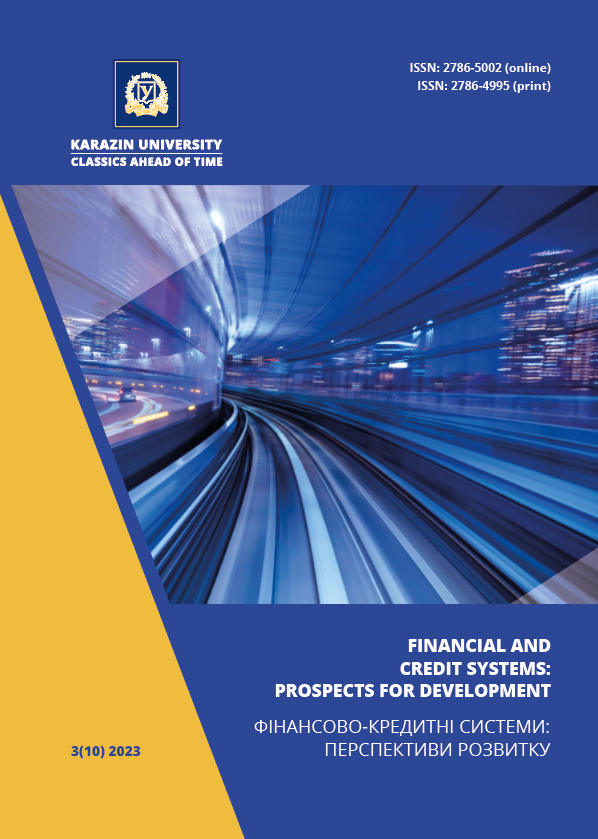Problems of determining the borrower's creditworthiness
Abstract
This article addresses the challenges associated with determining the borrower's creditworthiness. The authors define the borrower's creditworthiness as the ability to timely and fully meet debt obligations to the lender. This determination is based on an evaluation of the borrower's financial condition, forecast of business development, and other factors influencing the ability to repay the loan.
The authors identify internal and external factors affecting the creditworthiness of borrowers in Ukraine. Internal factors include the economic situation, regulatory policies, credit history, credit rating, and a lack of financial literacy. External factors encompass the global economic situation and the political climate.
The article also discusses challenges in determining the borrower's creditworthiness during times of war. The authors note that creditworthiness can sharply decrease during such periods due to factors such as reduced income, increased costs, decreased demand for goods and services, and an unstable economic situation.
To address these challenges during wartime, the authors propose the following recommendations:
- Widespread use of artificial intelligence: AI enables the consideration of more factors affecting the borrower's creditworthiness and the adaptation of credit scoring models to changes in the economic situation.
- Expansion of data on the borrower's financial condition: Financial institutions should utilize more data sources, including unstructured data such as social media and behavioral data, to assess the borrower's financial condition.
- Development of new methods for assessing creditworthiness: Financial institutions should create new methods that account for the specific conditions of wartime.
- Establishment of cooperation between financial institutions and government agencies: This collaboration will provide additional data on the financial condition of borrowers, offering financial institutions a more comprehensive view.
- Promotion of financial literacy among the population: Improving financial literacy will empower borrowers to better understand their financial obligations and make more informed lending decisions.
Implementing these recommendations will enable financial institutions to enhance the accuracy of creditworthiness assessments and, consequently, reduce credit risks during times of war.
Downloads
References
Astaf'eva, K. O. (2015). Assessment of creditworthiness of enterprises taking into account tax debts. In Socio-economic and legal foundations of the modern state in the context of globalization: International science and practice conference, February 20–21, 2015: theses add. Kyiv (pp. 74–77). [in Ukrainian]
Black, J., Hashimzade, N., & Myles, G. (2012). Oxford dictionary of Economics. New York: Oxford University Press.
Vyhovsky, V. G. (2013). Determination of creditworthiness in economic literature: Evaluation of approaches. Bulletin of ZHTU. Series: Economic Sciences, 2(64), 206–212. [in Ukrainian]
Gup, B. E. (2011). Banking and financial institutions: A guide for directors, investors, and counterparties. Hoboken, NJ: Wiley.
Omelechko, D. (2023). Assessment of creditworthiness of bank borrowers. Qualification work on specialty 051 "Economics," OPP "Economic Cybernetics." National Aviation University of the Ministry of Education and Science of Ukraine, Kyiv. [in Ukrainian]
Smoleva, T. M. (2017). Assessment of the borrower's creditworthiness: Problems and prospects. In Accounting and control in business management: Proceedings of the 5th International Scientific and Practical Conference, September 19-20, 2017. Kyiv: Eksklyuzyv-Sistem. URL: https://bit.ly/3tyFrCb [in Ukrainian]
Anderson, B. S. (2009). Developing Credit Scorecards Using SAS Credit Scoring for Enterprise Miner 5.3. Cary: SAS Institute Inc.
Hong Kong Monetary Authority. (2020). Alternative Credit Scoring of Micro-, Small and Medium-sized Enterprises. URL: https://www.hkma.gov.hk/media/eng/doc/key-functions/financialinfrastructure/alternative_credit_scoring.pdf
World Bank Group. (2019). Credit scoring approaches guidelines. URL: https://thedocs.worldbank.org/en/doc/935891585869698451-0130022020/original/CREDITSCORINGAPPROACHESGUIDELINESFINALWEB.pdf
Schroer, A. (2021). AI and the Bottom Line: 20 Examples of Artificial Intelligence in Finance. Uniting People Tech. URL: https://builtin.com/artificial-intelligence/ai-finance-banking-applications-companies
Copyright (c) 2023 Financial and credit systems: prospects for development

This work is licensed under a Creative Commons Attribution 4.0 International License.

